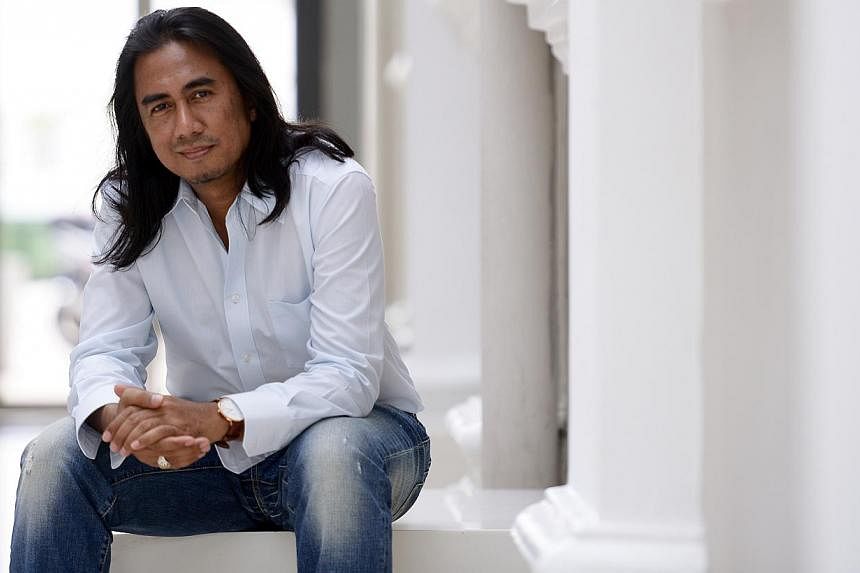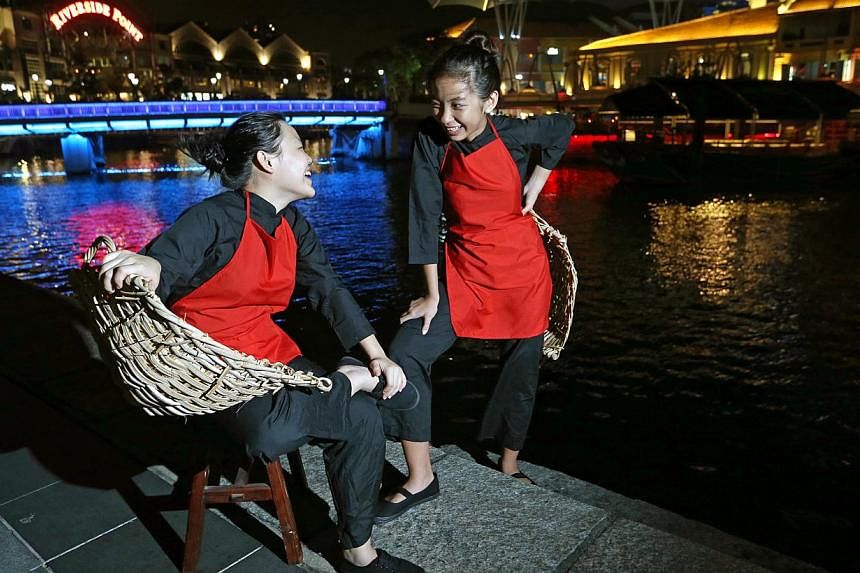Mingle with samsui women
The ghosts of Singapore River's past will be visiting their old haunt next month.
Well, metaphorically, at least. Ten characters from a book titled From The Belly Of The Carp, by Singaporean writer Roger Jenkins, will be played by actors in a site-specific performance on Read Bridge, near Clarke Quay.
The book, which won the Singapore Literature prize in 1995, contains 96 monologues spoken by fictional and historical characters who live and work near the river, such as a coolie or samsui woman (right).
The free shows will take place at various times on May 15 and 16.
Expect to encounter figures such as the orang laut (a native fisherman), a sinkeh (a new immigrant odd-job labourer), Sir Stamford Raffles and ice merchant Hoo Ah Kay, better known as Whampoa.
In addition, 15 other actors will also be roving the length of the river between Central Mall and Read Bridge between 6 and 10pm on May 15 and 16 dressed as characters such as samsui women, a fortune-teller and a letter-writer.
To complete the 1900s experience, there will even be a real-life snake charmer and a traditional riverside book stall where you can borrow books.
Traditional food will be sold from wooden push carts. This includes Chinese rice dumplings from third-generation business Hoo Kee Bak Chang and ding ding tong, or malt candy.
The history of the Singapore River is coming to life thanks to the work of Ms Sharon Lim, who is an assistant curator at the National Museum and project manager Gong Pan Pan, who put the programmes together as part of the Singapore HeritageFest.
They had been stirred by the scope and imagination of Jenkins' book in enlivening an important part of Singapore's past.
Ms Lim says: "We sing that line in Dick Lee's song Home, 'Sail down the river that brings us life', but a lot of us don't actually know what it actually means."
Writer Jenkins, 62, is pleasantly surprised by the renewed interest in his book. He says: "It's really thrilling that this book is speaking to a new generation. Particularly, the generation that never knew the old Singapore River, the working river."
The titular carp, by the way, comes from the fact that if you look at the segment of the river near Cavenagh Bridge on old maps, you will be able to discern the shape of the fish.
From May 15 to 19, there will also be a live projection of a carp on the surface of the river, for a more visual representation of the uniquely Singaporean folklore.
Rocking the heyday of Malay pop
Currently, the face of local Malay pop is probably defined by acts such as former Singapore Idol Taufik Batisah and hip-hop duo Sleeq.
But long before they hit the scene, local Malay music already had a long and varied history.
In the 1960s, there was pop yeh yeh, a brand of upbeat pop inspired by British bands such as The Beatles.
There was also Nusantara world music, influenced by ethnic music from the Indonesia archipelago.
And of course, there were the inevitable influences from 1970s disco and 1980s rock.
These aspects and more are covered in an exhibition called Ole Ole Temasek - 50 Years Of Singapore Malay Pop Music at the National Museum of Singapore. The show opens on April 17.
The exhibition includes rare artefacts such as Malay rock icon Ramli Sarip's acoustic guitar; a jacket belonging to Kassim Selamat, the lead singer of pop yeh yeh group The Swallows; and a trumpet belonging to the late Masron Matali from funk-rock band Black Dog Bone. Masron died last month from lung cancer.
There will also be video interviews with Ramli and another Malay music icon, M. Nasir, as well as sound booths for people to listen to music from the different periods.
The show is curated by singer-songwriter Art Fazil, 47, who has about 30 years of experience in the scene.
He also owns the Malaysia-based record label Moro Records.
He is especially passionate when talking about the heyday of Malay pop music between 1965 and 1971, a period he describes as a "massive explosion of pop culture", as Singaporeans found new ways of creative self-expression after the nation's independence.
He says: "People were going to tea dances every weekend, so bands had work. There were a lot of platforms to play at, such as bars and naval bases."
He estimates that there were more than 100 local music labels at the time, ranging from big names such as EMI and Columbia Records to small independent labels such as Panda and Camel Records.
"We had something that was unique, very strong and commercially viable," he says.
Things tapered off in the 1990s after Malaysia took over as the centre for the Malay language music industry.
As such, when putting together the exhibition, Art had a hard time sourcing for historical paraphernalia.
"Nobody keeps anything," he says.
"A lot of musicians have sold their old instruments and they don't have the clothes they wore on their album covers anymore."
Still, he managed to rustle up some interesting artefacts, such as old vinyls and album covers of iconic groups such as pop outfit A. Ramlie & The Rhythm Boys and rock band Sweet Charity.
He is completing the period feel with refurbished furniture of the 1960s and 1970s. He also hopes to score a Lambretta scooter, a retro motorcycle brand big in the pre-1970s era, to add to the experience.
Besides the exhibition, there will be talks about the different eras of Malay music, as well as an evening of pop yeh yeh performances by veteran artists such as singer Fatimah M. Amin, backed by young local band The Pinholes, outside The Cathay on May 16.
Ultimately, he hopes to publish a book based on his extensive research and to inspire other musicians to document their own journeys.
"I hope they will realise there is some value in this - sentimental value. It will become part of their history."
Catch made-in-Singapore old films
The late entertainment mogul Run Run Shaw was a titan of the regional film industry, having founded the Shaw Brothers Studio, one of the largest film production companies in Hong Kong, and TVB, the dominant television company there.
In Singapore, he is probably most associated with the chain of Shaw Theatres located across the island.
Learn how he built up his business in an upcoming exhibition titled The Foundation Of Run Run Shaw's Cinema Empire, opening at the National Museum on May 1. The exhibition is travelling here from Hong Kong, where it was mounted by the Hong Kong Film Archive on the first death anniversary of Shaw. He died in Hong Kong in January last year at the age of 106.
The show traces the growth of the Shaw Brothers empire, from its start as a family business in the 1920s till today, paying tribute to Shaw's contributions to the film industry in Singapore and Hong Kong. By 1958, they owned 120 theatres across the region, including Singapore, Vietnam, Hong Kong and Taiwan.
In particular, the exhibition highlights Shaw's important role in building up the Malay film industry from the post-war years to the 1960s, which was termed the Golden Age of Malay cinema.
"It was very multi-cultural in those days," says assistant curator Yap Soo Ei.
"You'd see Shaw Brothers as a Chinese film company, but it helped build up the Malay film industry, bringing together people such as actor P. Ramlee with Indian film director L. Krishnan."
Madras-born L. Krishnan was credited with having given a young Ramlee his first break as the lead in his directorial debut film, Bakti (Faithfulness) in 1950, launching both their illustrious careers. It was produced by Malay Film Productions, under Shaw Brothers.
On top of family photos and personal letters, old movie posters, handbills and newspaper advertisements will also be displayed. Look carefully and you may be able to pick out some nostalgic names and places, such as the Merdeka Bridge that stretches along the Kallang Basin.
Visitors can also see the Singapore of old through the screening of 32 old movies produced by the Shaw brothers.
Some of these films have not been screened since their first showing, such as Sri Menanti (1958), a film about an inter-racial romance set in Malaya that starred Malay and Hong Kong Chinese actors. Two versions of Sri Menanti were released back then, Malay and Mandarin, to cater to the different markets.
Says Ms Soo: "By watching these films, we can construct a shared memory about the spaces that we grew up with."
Relive colourful life of New World
An older generation will have fond memories of New World Amusement Park, a colourful theme park filled with nightclubs, rides and games situated in Jalan Besar. It entertained Singaporeans for 60 years before it closed in 1987.
Now, all that is left of the place is a gateway bearing the name "The New World" at City Square Mall.
But thanks to a new exhibition at that same shopping centre, you can relive the colourful heyday of New World, which was declared Malaya's "pioneer amusement park" by its owners Ong Peng Hock and Ong Boon Tat at its opening in 1923.
Held from April 27 to May 3, New World of Singapore will paint a picture of the theme park and its historical significance with photographs and videos. There will also be live performances of the kinds of dances and songs popular in the nightlife spot.
New research will also reveal lesser-known facts about New World. For example, it was the site that launched a number of arranged marriages as families often set their children up on dates there.
The curators Tan Teng Teng and Genine Loo said New World was the first entertainment spot in Singapore that was accessible to the public. Visitors paid a small entrance fee and could enjoy all the park's facilities.
Before New World opened, such nightlife spots were available only to the Europeans or the well-heeled.
New World was also significant in setting other records. It was once advertised as having the largest air-conditioned cabaret East of the Suez, and had Singapore's first open-air raised stage for dance performances.
Unsurprisingly, it attracted interesting characters who gave the place a seedier reputation. Cheongsam- wearing "taxi girls" were so-called because men could purchase dances with them, whether Malay folk dances such as joget and ronggeng, or the ubiquitous cha-cha.
Some big names started their careers at New World as well, such as a-go-go singer Sakura Teng and exotic dancer Rose Chan, known locally as the Queen of Striptease.
The exhibition will pay special tribute to Chan. Besides being known for acts which involved python wrestling and bending iron rods with her throat, she also did a lot of charity work.
To bring the experience of New World to life, there will be live performances on May 1 and 2, including cabaret and joget dances.
"Taxi girls" will also share a dance with visitors while a singer will serenade the crowd with English and Chinese tunes.






